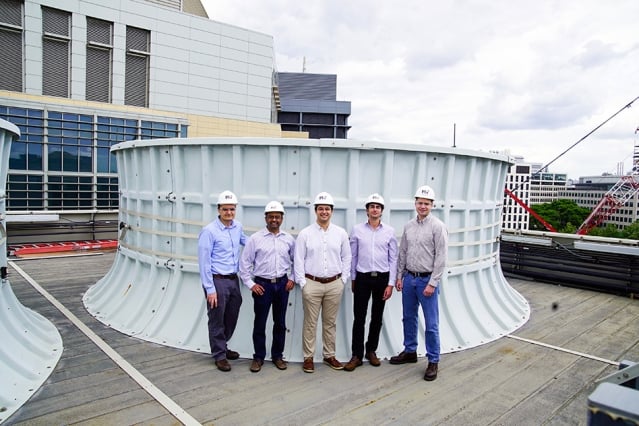All around the world, the cooling needs of power stations – whether they are fossil fuelled or nuclear – accounts for a large percentage of water usage. Some of that water is fresh (in the US, 39 per cent of water withdrawn from rivers lakes and reservoirs is used for power station cooling) and some of it is seawater, but in either case much of that water floats away from cooling towers as vapour. The MIT team, inspired by systems used to recover water from sea-fogs, has devised a method to recover a large percentage of that lost water in a drinkable form.

Fog catchers use a plastic or metal mesh hung in the path of the fog to condense it and recover the water. They are often used in water-scarce coastal areas, but are very inefficient, capturing only 1-3 per cent of the water droplets that pass through them. In laboratory studies, PhD student Maher Damak and mechanical engineer Kripa Varanasi found that the aerodynamics of the system led to the inefficiency. As a vapour-laden air stream passes through the mesh, the individual strands force the airflow to deviate, carrying water droplets away from the strand.
The researchers countered this effect by using an ion beam to charge water particles before they encounter the mesh. Charged droplets are pulled towards the strands, even if their trajectory would have taken them through holes in the mesh. Damak and Varanasi realised that this could also be effective for the clouds of vapour produced by cooling towers, as the vapour produced is more concentrated than natural fog. Recruiting another graduate student, Karim Khalil, the researchers worked on a demonstration system and achieved good results, capturing 20 to 30 per cent of the water in the vapour. “It’s distilled water, which is of higher quality, that’s now just wasted,” says Varanasi. “That’s what we’re trying to capture.” This is particularly relevant where the cooling water comes from the sea, because the cooling system effectively removes the salt. The researchers have published their research in the journal Science Advances, and have formed a start-up company called infinite cooling that last month won MIT’s $100,000 entrepreneurship competition.
The team is now constructing a test system that will be placed on the cooling tower of MIT's Central Utility Plant, a natural gas-fired cogeneration system that supplies electricity, heating and cooling for the whole campus. Tests on the system will include varying the mesh and its supporting structure. This will help to de-risk the technology, making it more attractive to potential investors and also improving MIT’s water usage. The researchers hope that this will help capture even more of the water in cooling system vapour.
One major advantage of this system is that it could reduce the cost of desalination. Damak and Varanasi estimate that the installation cost of converting a power station on an arid coastline into a desalination unit would be a third of the cost of building a new, dedicated desalination plant and operating costs would only be 1/50 of such a plant. The payback time for installing such a system would be about two years, Varanasi says, and it would have essentially no environmental footprint, adding nothing to that of the original plant.
“This can be a great solution to address the global water crisis,” she said. “It could offset the need for about 70 per cent of new desalination plant installations in the next decade.”




Glasgow trial explores AR cues for autonomous road safety
They've ploughed into a few vulnerable road users in the past. Making that less likely will make it spectacularly easy to stop the traffic for...